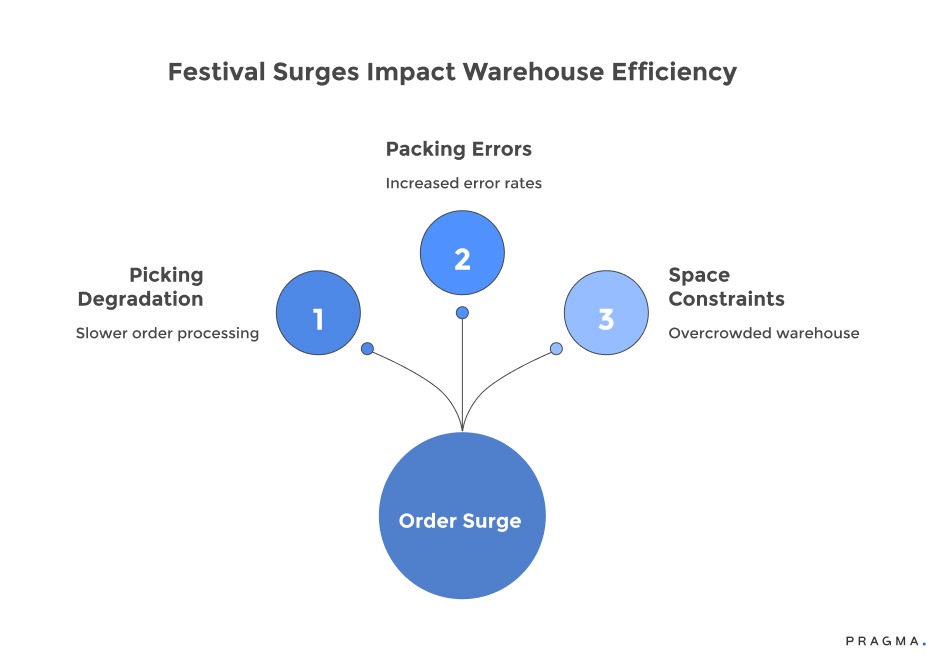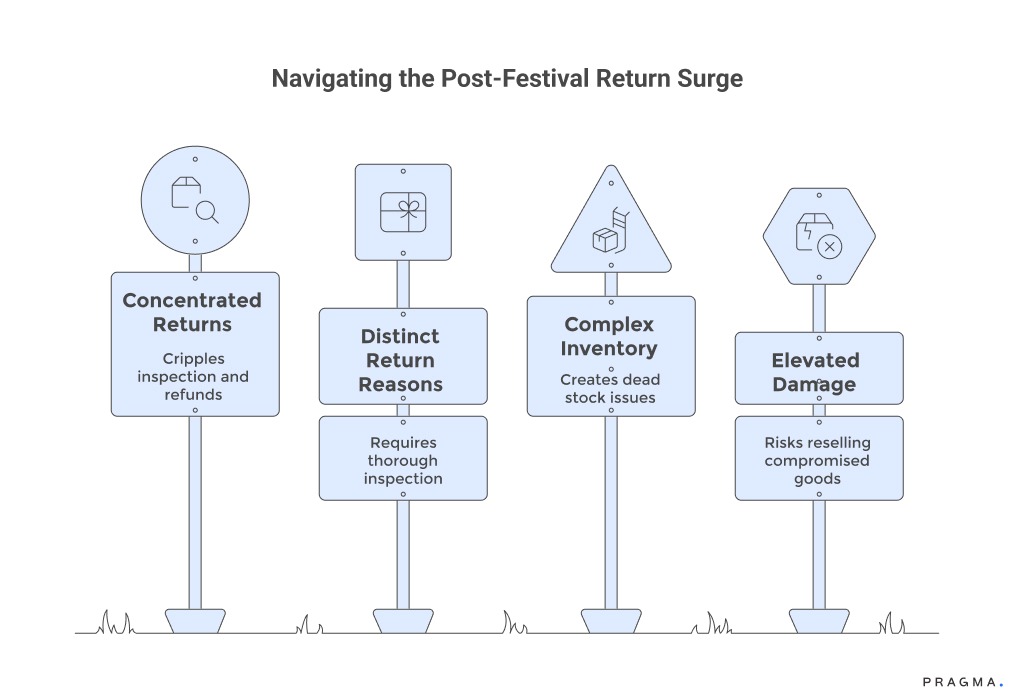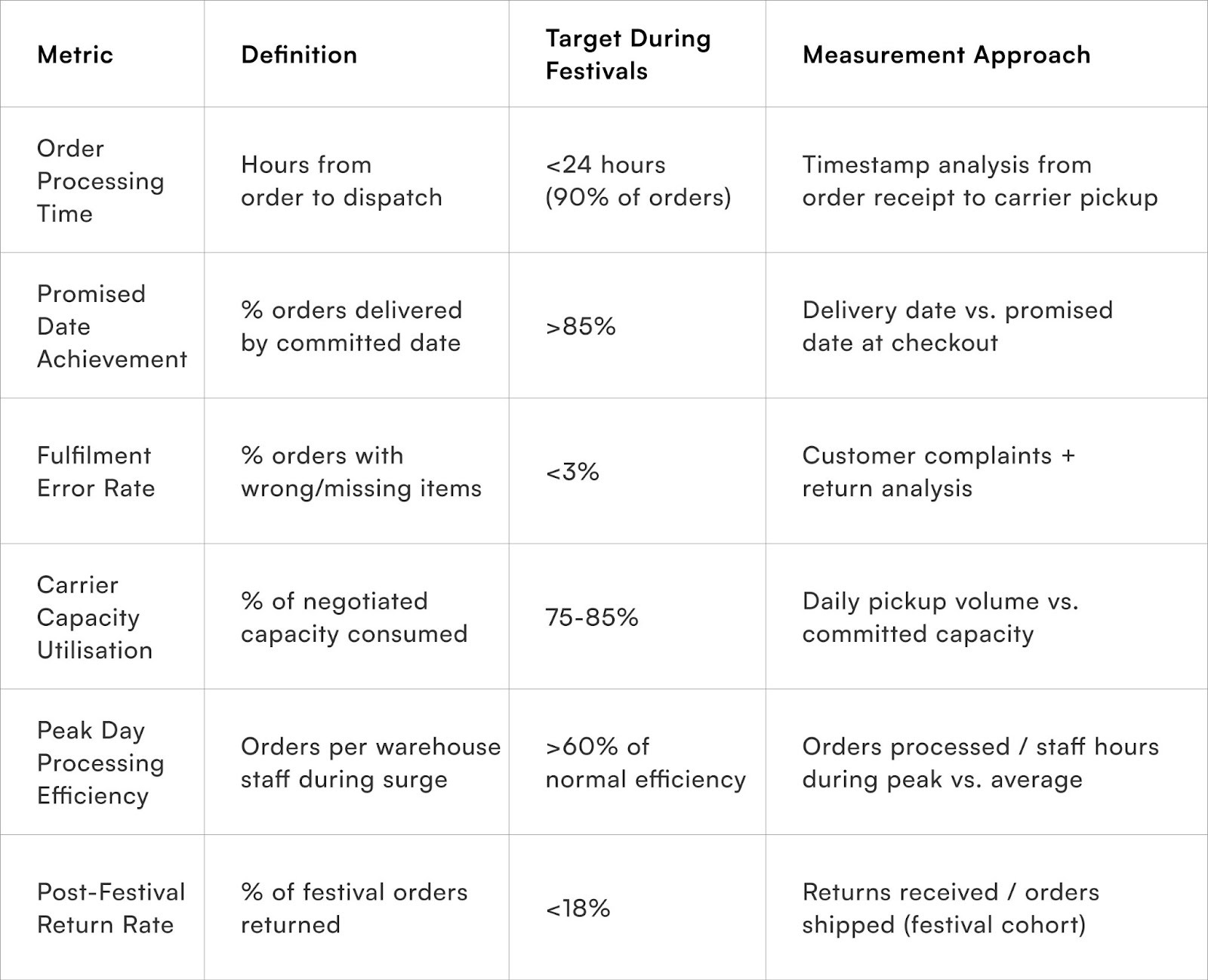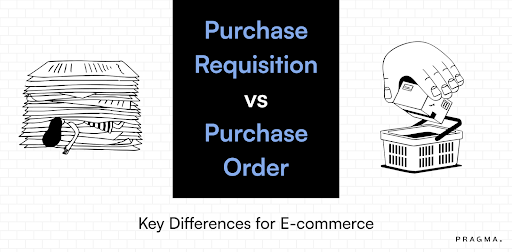Diwali morning arrives and your warehouse team stares at 4,200 unprocessed orders from the previous 48 hours. Customers expect delivery before the festival. Your regular carrier partner stopped accepting pickups two days ago. Social media fills with angry comments about missing gifts whilst your support team drowns in 800+ pending tickets.
Festival campaigns generate 240-380% revenue spikes during India's peak shopping periods, yet 42% of D2C brands report fulfilment failures that permanently damage customer relationships during these crucial windows. Brands investing ₹3-6 lakhs in festival advertising watch conversion rates climb to 8-12% only to lose 55-70% of new customers through delivery failures. The economics prove devastating—acquiring customers at ₹950-1,400 each during competitive festival periods, then losing them before second purchases occur.
In this comprehensive guide on common pitfalls in festival campaign fulfilment for Indian D2C brands, we're diving deep into the operational breakdowns that transform revenue opportunities into retention disasters.
We'll uncover why certain fulfilment mistakes cost brands 60-85% of festival-acquired customers whilst systematic preparation enables 45-52% retention rates, and how avoiding predictable pitfalls converts seasonal spikes into sustainable customer base expansion.
What inventory mistakes create the most damaging fulfilment failures?
Stock positioning errors compound into delivery disasters that destroy customer trust
Inventory planning represents the earliest fulfilment decision point, yet brands consistently make three critical mistakes that guarantee downstream failures regardless of execution quality. These errors prove particularly costly because they become irreversible once campaigns launch.
Insufficient safety stock proves the most obvious yet persistent mistake. Brands calculate festival demand at 3x normal volumes then stock exactly 3x inventory, leaving zero buffer for forecast errors or suppressed demand from previous stockouts. When actual demand reaches 3.4x projections, popular SKUs sell out within 36-48 hours, creating frustrated customers and wasted advertising spend.
Poor SKU mix planning causes more subtle damage. Festival shoppers demonstrate different preferences than regular customers, favouring gift sets, premium products, and festive variants. Brands stocking proportional increases across all SKUs discover that 60-70% of festival demand concentrates in 15-20% of catalog, creating simultaneous stockouts and dead inventory.
Geographic distribution failures create unnecessary delivery delays and costs. Brands centralising inventory in single locations face 4-6 day delivery timelines to distant markets during festival periods when carrier networks strain. Smart competitors pre-position stock across 3-4 regional hubs, enabling 2-3 day delivery nationally even during peak congestion.

Why do warehouse operations collapse under sudden volume surges?
Process efficiency inversely correlates with order velocity during compressed timeframes

Warehouse operations optimised for steady throughput encounter physics problems when order volumes compress into 48-72 hour windows. The same team processing 1,000 daily orders efficiently struggles with 4,000 daily orders not because of inability but because operational systems weren't designed for surge dynamics.
Picking efficiency degrades significantly under pressure. During normal operations, pickers follow optimised routes through warehouse zones, handling 80-100 orders per shift. Festival surges create congestion where multiple pickers compete for the same inventory locations, slowing everyone to 45-60 orders per shift despite longer hours and additional staff.
Packing error rates spike dramatically. Quality control systems assuming reasonable throughput rates prove inadequate when teams rush to process urgent orders. Wrong products, missing items, and inadequate packaging increase from baseline 1-2% error rates to 6-9% during peak periods, creating expensive return flows and damaged customer relationships.
Space constraints compound these problems. Warehouses scaled for normal inventory levels become dangerously overcrowded when festival stock arrives alongside regular inventory. Walking distances increase, picking slows, and staging areas for packed orders overflow into operational space, creating cascading efficiency losses.
Mumbai personal care brands demonstrate optimal surge management. They establish temporary satellite packing stations in adjacent spaces during festivals, train 8-10 temporary staff three weeks before campaigns, and implement simplified picking protocols for high-velocity SKUs. These preparations enable 85-90% normal efficiency at 3.5x volumes compared to unprepared competitors achieving just 50-60% efficiency.
What communication failures amplify fulfilment problems into relationship disasters?
Operational delays become retention catastrophes when brands go silent during crises
Fulfilment problems during festivals prove inevitable given systemic constraints. The difference between brands recovering customer relationships versus losing them permanently lies entirely in communication approach when problems occur.
Silent delays represent the most damaging communication failure. Brands discovering they cannot meet promised delivery dates often freeze, hoping situations resolve before customers notice. This approach guarantees maximum damage as customers watch tracking pages stagnate, file support tickets, and ultimately cancel orders or leave negative reviews.
Generic delay notifications provide minimal value without specificity. Messages stating "your order is delayed" create more anxiety than clarity. Customers want concrete information—current location, revised delivery date, explanation of delay cause, and compensation offers if appropriate.
Reactive communication waits for customer complaints rather than proactively addressing issues. Brands learning of carrier delays often wait for customers to inquire rather than immediately notifying all affected orders. This approach makes customers feel ignored whilst multiplying support ticket volumes.
Pune jewellery brands showcase effective crisis communication. When their primary carrier implemented pickup restrictions during Dhanteras 2023, they immediately sent WhatsApp messages to all affected customers explaining the situation, providing revised delivery dates, offering full refunds for cancellations, and including ₹200 discount codes for future orders. This proactive transparency resulted in just 12% cancellation rates compared to industry averages of 45-60% for similar delays.
How do return logistics amplify post-festival operational chaos?
Festival order returns create secondary fulfilment crises brands fail to anticipate
Navigating the Post-Festival Return Deluge: Key Challenges for Indian D2C Brands

1. Concentrated Return Volumes:
Unlike the gradual inflow of normal returns, festival returns arrive in a highly concentrated period, typically within a 10-15 day window. Brands accustomed to processing 15-20 daily returns can suddenly face 200-300 returns clustered within two weeks. This overwhelming volume can cripple workflows for inspection, refund processing, and inventory restoration.
2. Distinct Return Rationales:
Festival returns often stem from different reasons. Many items, particularly gifts, are returned not due to defects but because they simply don't align with the recipient's preferences. These returns necessitate thorough inspection and repackaging before they can be resold, demanding more resources than typical exchange-focused returns.
3. Complex Inventory Management:
Returns of limited edition festive packaging and gift sets introduce significant inventory complications. These unique SKUs cannot easily be reabsorbed into regular inventory, leading to dead stock that ties up crucial working capital. Many brands lack established protocols for managing these specialised items, resulting in ad-hoc decisions and profit erosion.
4. Elevated Quality Control Concerns:
Post-festival returns frequently exhibit higher rates of damage. Products that have undergone multiple logistical touchpoints—from warehouse to customer and back for pickup—are more prone to damage. Without stringent inspection protocols, brands risk reselling compromised products, which can lead to a cascade of customer service issues.
Why do brands consistently underestimate festival fulfilment complexity?
Planning assumptions based on normal operations fail catastrophically under 3-5x volume pressure
Most D2C brands approach festival campaigns through marketing lenses, focusing on creative assets and promotional mechanics whilst treating fulfilment as scalable infrastructure. This fundamental miscalculation stems from missing how operational systems behave under stress.
Normal month operations processing 800-1,200 daily orders develop comfortable rhythms where teams handle variations smoothly. Festival campaigns generating 4,000-6,000 daily orders don't simply multiply existing workflows—they break them entirely. Warehouse processes designed for steady flow collapse under batch pressure. Carrier relationships sufficient for regular volumes prove inadequate when everyone simultaneously needs capacity.
Bangalore fashion brands demonstrate this pattern repeatedly. Teams successfully handling 25,000 monthly orders assume proportional scaling to 75,000 orders during Diwali week. The reality involves entirely different operational physics where picking efficiency drops 40-55%, packing error rates triple, and carrier partnerships evaporate precisely when needed most.
Analysis of 80+ D2C festival campaigns across 2023-2024 reveals that 67% of fulfilment failures stem from capacity assumptions rather than execution problems. Brands correctly forecast demand but incorrectly assume infrastructure scales linearly, discovering too late that 3x volume requires 5-7x operational capacity when accounting for efficiency degradation under pressure.
What communication failures amplify fulfilment problems into relationship disasters?
Operational delays become retention catastrophes when brands go silent during crises
Common Communication Pitfalls:
- Silent Delays: Brands often delay informing customers about missed delivery dates, hoping the situation resolves. This approach is highly damaging as customers observe stagnant tracking, file support tickets, and ultimately cancel orders or leave negative reviews.
- Generic Notifications: Vague messages like "your order is delayed" cause more anxiety than clarity. Customers require specific details: current location, revised delivery dates, reasons for delays, and potential compensation.
- Reactive Communication: Waiting for customer complaints instead of proactively addressing issues. Brands that delay notifying customers about carrier delays, for instance, make customers feel ignored and increase support ticket volumes.
Effective Crisis Communication:
Pune jewellery brands offer a strong example of managing crisis communication. During Dhanteras 2023, when their primary carrier restricted pickups, they promptly sent WhatsApp messages to affected customers. These messages explained the situation, provided new delivery dates, offered full refunds for cancellations, and included ₹200 discount codes for future purchases. This proactive and transparent approach resulted in a significantly lower cancellation rate of just 12%, compared to an industry average of 45-60% for similar delays.
What structural changes prevent recurring festival fulfilment failures?
Moving from reactive firefighting to systematic surge preparedness requires operational redesign
Key strategies for systematic surge handling include:
- Modular Warehouse Operations:
Instead of a single workflow for all orders, successful brands separate order types. High-volume SKUs get dedicated packing stations with simplified processes, complex orders follow standard workflows, and B2B shipments have entirely different protocols. This prevents surges in one category from disrupting others.
- Year-Round Carrier Relationship Management:
Building consistent relationships with carriers throughout the year, not just during festivals, secures preferential treatment during peak times. Providing carriers with 60-90 day advance volume forecasts enables better capacity planning for both parties. Strategic brands even allocate 5-10% more to carrier spending during slower months to ensure priority during crucial festival periods.
- Dynamic Inventory Positioning Systems:
These systems continuously optimise stock location based on real-time regional demand patterns, rather than static annual planning. Utilising sales velocity data to trigger regional transfers improves stock availability and reduces delivery times. During festivals, these systems automatically prioritise fast-moving SKUs for optimal positioning.
- Pre-Festival Stress Testing:
Simulating festival conditions during off-peak periods helps identify breaking points before they become critical. For example, some brands conduct quarterly "stress test days" where teams process three times their normal volume in a compressed timeframe, identifying constraints and training staff on surge procedures in a low-stakes environment.
Metrics That Matter: Festival Fulfilment Performance

Quick Wins
Week 1: Audit Festival Readiness Across Fulfilment Chain
Document current warehouse capacity, processing speed under stress testing, carrier agreements with pickup guarantees, and inventory positioning by location. Interview warehouse and logistics teams about previous festival experiences identifying specific breakdown points.
Calculate fulfilment capacity ceiling accounting for 40% efficiency degradation under surge.
Expected result: Accurate capacity assessment revealing specific constraint areas requiring attention before campaigns launch.
Week 2: Secure Carrier Commitments and Backup Partners
Negotiate written capacity commitments from primary carrier specifying minimum daily pickup volumes during festival period. Establish secondary carrier relationship with pre-negotiated rates and service levels as backup. Create carrier allocation matrix assigning percentage of daily orders to each partner preventing single-point failures.
Expected result: Documented carrier capacity covering 120-150% of forecast peak volumes with contractual protections.
Week 3: Establish Crisis Communication Templates
Create pre-written message templates for five scenarios—minor delays, major delays, stockouts, carrier failures, and quality issues. Include specific placeholders for revised timelines, compensation offers, and support contact information. Set up automated trigger systems sending appropriate messages when delivery timelines exceed thresholds.
Expected result: Communication infrastructure enabling immediate transparency when problems occur rather than reactive scrambling.
Week 4: Implement Inventory Monitoring and Circuit Breakers
Build real-time dashboard tracking SKU-level inventory coverage in days at current order velocity. Configure automatic advertising pause triggers when top-20 SKUs drop below seven days coverage. Establish daily review protocols examining inventory burn rates and adjusting marketing spend to prevent stockouts.
Expected result: Dynamic inventory-marketing coordination preventing overselling whilst maximising revenue from available stock through festival period.
To Wrap It Up
Festival campaigns represent concentrated opportunities that either accelerate D2C growth trajectories through customer base expansion or destroy profitability through operational failures that permanently damage brand reputation.
The difference lies not in avoiding problems—festival surges guarantee constraints—but in anticipating specific failure modes and implementing systematic preparations that transform inevitable challenges into manageable complications rather than relationship-ending disasters.
This week, calculate your true fulfilment capacity ceiling by stress-testing warehouse operations at 3x normal volumes, then negotiate written carrier commitments for festival period pickup capacity covering 150% of your peak forecast to prevent the most common failure mode—adequate inventory with no shipping capacity.
Sustainable festival success requires shifting from viewing campaigns as marketing events with fulfilment implications to recognising them as operational challenges requiring marketing support. Brands that invest equally in warehouse capability, carrier relationships, and crisis communication infrastructure alongside creative assets and advertising budgets achieve 40-55% retention of festival-acquired customers compared to 8-15% retention for brands treating fulfilment as solved infrastructure.
The operational discipline developed through festival preparation compounds into year-round excellence that becomes genuine competitive advantage as markets mature and customer expectations rise.
For D2C brands seeking to transform festival chaos into systematic growth opportunities, Pragma's fulfilment orchestration platform provides predictive capacity planning, multi-carrier coordination systems, and automated customer communication workflows that help brands achieve 85-92% on-time delivery rates during festival surges whilst reducing fulfilment costs by 18-28% through intelligent carrier allocation and inventory positioning optimisation.

FAQs (Frequently Asked Questions On Common Pitfalls in Festival Campaign Fulfilment for Indian D2C Brands)
1. How early should brands start festival fulfilment planning?
Serious preparation requires 75-90 days lead time for major festivals like Diwali and Dussehra. Inventory procurement begins 60-75 days out, carrier negotiations happen 45-60 days before, and warehouse preparation starts 30-45 days prior.
Brands beginning festival planning less than 45 days out inevitably face constraint-driven compromises that damage execution quality.
2. What percentage of festival demand should brands plan safety stock for?
Conservative planning suggests 35-50% safety stock above forecast for established brands with reliable demand data, and 50-75% safety stock for brands running first or second festival campaigns where forecast uncertainty proves higher.
This buffer prevents stockouts during demand surges whilst remaining economically viable since excess inventory gets sold during post-festival periods at modest discounts.
3. Can brands successfully run festival campaigns using only marketplace fulfilment?
Marketplace fulfilment services like Amazon FBA and Flipkart Assured handle surge operations effectively but impose significant margin compression through 25-35% fulfilment fees during peak periods. Brands grossing under ₹50 lakhs monthly often find marketplace fulfilment optimal, whilst larger operations benefit from hybrid approaches using owned warehouses for profitable orders and marketplace fulfilment for geographic expansion.
4. How should brands handle orders placed during festivals that cannot ship on time?
Transparent communication immediately after order placement proves crucial—notify customers of realistic revised timelines within 2-4 hours, offer full refunds for cancellations without friction, and provide compensation like ₹150-300 discount codes for future orders if delays exceed 3-5 days.
This approach maintains 40-55% order retention compared to silent delays generating 10-20% retention.
5. What crisis backup plan should brands have when the primary carrier fails during festivals?
Effective contingency requires pre-negotiated agreements with 2-3 backup carriers activated through single phone call, relationships with regional courier partners covering specific zones, and reserved emergency budget for premium logistics at 1.5-2.5x normal rates. Brands should document trigger points
if the primary carrier misses pickups for 24 hours or quotes delivery timelines exceeding promised dates by 3+ days, immediately activate backup protocols rather than hoping situations improve.
Talk to our experts for a customised solution that can maximise your sales funnel
Book a demo



.png)
.png)